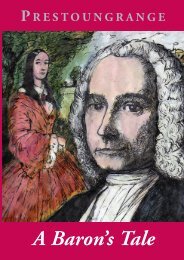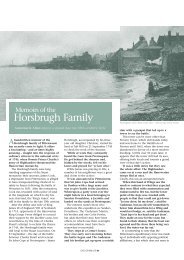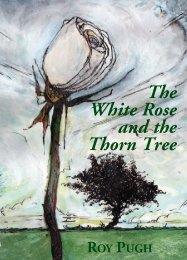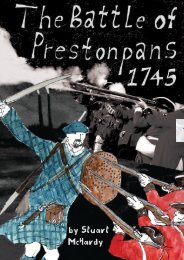Visitors Guide - Prestoungrange.org
Visitors Guide - Prestoungrange.org
Visitors Guide - Prestoungrange.org
Create successful ePaper yourself
Turn your PDF publications into a flip-book with our unique Google optimized e-Paper software.
T<br />
O THE EAST of Edinburgh are<br />
many reminders of Scotland’s<br />
industrial past, especially the ‘black<br />
stanes’, which had such an impact on<br />
the land and its people.<br />
The Lothian Coal Trail traces this<br />
history from its earliest origins up to<br />
the industrial complexes of the 19th<br />
and 20th centuries. Some points on<br />
the trail, such as Lady Victoria<br />
Colliery, are vast monuments to<br />
heavy industry while others, like the<br />
hummocky land beneath the trees<br />
on Birsley Brae, are no longer<br />
recognisable as industrial sites.<br />
Newbattle Abbey<br />
They all have one thing in common:<br />
they are all part of the history of<br />
coal mining in the Lothians, from its<br />
earliest beginnings up to the closure<br />
of the last deep mines during the<br />
second half of the 20th century.<br />
Prestonpans looking at Cockenzie Power Station<br />
Jackie Crookston, Tranent<br />
The Gothenburg offers a range of facilities to those<br />
interested in local traditions and history, microbrewed<br />
original real ales and maps of the town’s Murals Trail,<br />
which leads visitors round many historic sites in and<br />
around Prestonpans. The ideal spot for recreation at the<br />
end of the Coal<br />
Trail with beach<br />
murals on the<br />
John Muir Way.<br />
And all those who<br />
can correctly<br />
answer eleven fair<br />
questions, one for<br />
each location, will<br />
receive a beverage<br />
of their choice<br />
Be sure to visit!<br />
Prestongrange Colliery © Scottish Mining Museum Trust.<br />
Front Cover photograph © Jim Dickson.<br />
The<br />
Coal<br />
LOTHIAN<br />
TRAIL<br />
The John Muir/Gothenburg Mural.<br />
No. 7 of the series to be seen in<br />
Prestonpans.<br />
Prestongrange Mural.<br />
No. 3 of the series to be seen in Prestonpans.<br />
<strong>Prestoungrange</strong> Arts Festival Society,<br />
The Gothenburg, 227 High Street, Prestonpans,<br />
East Lothian EH32 9BE.<br />
Telephone: 01875 819 922.<br />
www.prestoungrange.<strong>org</strong>/arts-festival
1 5 7<br />
The trail begins at Newbattle Abbey. Take the A7<br />
out of Edinburgh and cross the City Bypass at the<br />
Sherrifhall Roundabout, continuing on the A7 to the next<br />
roundabout. Take the B6392 to the Eskbank Roundabout,<br />
then the B703 (Newbattle Road) to arrive at Newbattle<br />
Abbey College (private). From the foundation of the<br />
Abbey’s foundation in 1140 until the Reformation in the<br />
16th century, the Cistercian monks of Newbattle<br />
controlled vast areas of land in the Lothians. After the<br />
Reformation, much of this land passed into the hands of<br />
the Marquis of Lothian. During the 19th century, the<br />
ninth Marquis was responsible for building Lady Victoria<br />
Colliery. In 1937 house and grounds were gifted to the<br />
Scottish people and Newbattle Abbey is now a residential<br />
College. The present building is a 16th Century house<br />
with little remaining of the original abbey.<br />
2<br />
Continue on the B703, linking up with the A7 once<br />
more to arrive at Lady Victoria Colliery and nearby<br />
Newtongrange. Although the former Lady Victoria<br />
Colliery at Newtongrange is only a few minutes’ drive<br />
from Newbattle, historically, it is many hundreds of years<br />
away. One of the finest surviving examples of a Victorian<br />
colliery in Europe, it was closed in 1981 and reopened in<br />
1984 as The Scottish Mining Museum. Dedicated to the<br />
preservation of Scotland’s mining heritage, its facilities<br />
include a <strong>Visitors</strong>’ centre with audio-visual exhibitions,<br />
an underground roadway and coalface, and the largest<br />
winding engine in Scotland. For information on charges<br />
and opening hours, call 0131 663 7519<br />
Lady Victoria Colliery<br />
Leaving Dalkeith on the A68, travel away from<br />
Edinburgh, turning left on to the A6093, then left again<br />
on to the B6371 for Ormiston. During the first half of<br />
the 18th century, John Cockburn rebuilt Ormiston as a<br />
‘model’ village and established a range of local industries.<br />
By the late 19th century, large-scale mining operations<br />
were taking place and the village grew in response to the<br />
need for housing. A short walk along the route of the<br />
dismantled mineral railway offers a glimpse of the scale of<br />
these past operations, with way markers identifying the<br />
site of each colliery. To follow the route, walk west from<br />
the High Street, turn right at Ormiston Miners’ Club on<br />
to Ge<strong>org</strong>e Street. And join the path at the end of<br />
Ge<strong>org</strong>e Street. After approx. 0.5 km, turn to the right<br />
just before a bridge. Walk down to the connecting path<br />
and turn left under the bridge. For the remainder of the<br />
route turn left at each fork in the path to complete a<br />
loop around Ormiston. On leaving the path, turn left to<br />
return to the village.<br />
Way marker at Ormiston Birsley Brae –<br />
a medieval coal heugh<br />
Meadowmill, with its playing fields, sports centre<br />
and bowling club was one of Scotland’s earliest attempts<br />
to reclaim a former colliery site. The old ‘bing’ or spoil<br />
heap, has been transformed into a viewpoint with an<br />
excellent view of the East Lothian coastline and an<br />
information board offering a brief history of the Battle of<br />
Prestonpans, which took place only a few hundred<br />
metres to the north.<br />
8<br />
Return to Tranent and head towards Edinburgh on<br />
the A199. Approximately 0.75 km along this road, turn<br />
left up a minor road opposite the Jet Garage. Immediately<br />
to the right is a triangular, tree-covered piece of land.<br />
Beneath these trees is a medieval coal heugh, now<br />
designated an ancient monument. Mining at Birsley<br />
continued even into the late 19th century, ending<br />
only when the Prestongrange Mining Company – in<br />
what one local historian described as ‘a fit of pique<br />
or pigheadeness’ –<br />
responded to a dispute<br />
with another local mine<br />
owner by ordering its<br />
new shaft and equipment<br />
to be blown to pieces<br />
and its new engine house<br />
pulled down. It is<br />
reported that the stones<br />
were used in the<br />
construction of Tranent<br />
Town Hall.<br />
9<br />
Continue along the<br />
minor road for approx.<br />
2 kms. Just before the<br />
road takes a sharp turn<br />
to the left is Fa’side Castle (private).<br />
This castle, restored in the second half of<br />
the 20th century, is typical of many<br />
fortified houses in the Lothians and is an<br />
excellent example of the home of a<br />
wealthy landowner. The coal heuch at<br />
Fa’side, has a dark history: in the late<br />
16th century, a miner, John Henry, was<br />
found guilty of setting fire to the coal. He<br />
was hanged and his head set on a pole<br />
outside the mine as a warning to others.<br />
Fa’side Castle<br />
3<br />
The village of Newtongrange was<br />
built to house miners and others working at<br />
Lady Victoria Colliery. Newtongrange is the<br />
largest surviving coal company village in<br />
Scotland and its houses were a vast improvement<br />
on previous living conditions, where miners’<br />
wives struggled to keep their families clean and<br />
fed in homes which were little more than damp,<br />
squalid hovels. The Dean Tavern on Main Street is<br />
one of the few remaining public houses in Scotland<br />
which has continuously operated the ‘Gothenburg’<br />
system of management (based on the principle of<br />
redistributing profit from the sale of alcohol for the<br />
benefit of the local community) since its opening in 1899.<br />
Newtongrange<br />
4<br />
On leaving Newtongrange, take the B6482, turning<br />
left on to the A68 to arrive in Dalkeith. In Dalkeith, in<br />
1445, Aeneas Silvius, later Pope Pius II, reported the<br />
handing out of ‘black stones’ as alms to the local poor. In<br />
the 17th and 18th centuries, the town expanded rapidly<br />
in response to industrial and agricultural innovation. One<br />
of the earliest railways in Scotland, the Innocent Railway,<br />
built in 1831, linked its grain and coal merchants with<br />
markets in Edinburgh. By the 19th century, the railway<br />
network – which today forms a series of pedestrian<br />
routes across Mid and East Lothian – linked coal suppliers<br />
to national and international markets.<br />
6<br />
Continue on the B6371 to arrive in Tranent. The<br />
town was at the centre of a patchwork of drift mines,<br />
‘ingaun ee’s’ and other mineworkings and its ‘cole pits’<br />
were famous throughout Scotland. In 1995, an<br />
archaeological investigation of an iron age settlement at<br />
Port Seton revealed that coal was being quarried in this<br />
area more than two thousand years ago. To follow the<br />
route of the Tranent Waggonway, begun in 1722 to<br />
transport coal to the harbour at Cockenzie and the<br />
earliest waggonway in Scotland, start from Bridge Street,<br />
taking the path which runs downhill below Bridge Street.<br />
By 1946, the former waggonway joined the harbour to<br />
the Fleets pit at Tranent and mineworkings at Ormiston,<br />
linking with the mineral railway serving Dalkeith. The<br />
waggonway route at Tranent is known as ‘The Heugh’<br />
and is itself the site of ancient mine workings. The path<br />
continues across fields, passing under the Tranent by-pass<br />
to arrive at Meadowmill, before continuing across the<br />
B1361 to Cockenzie.<br />
10<br />
Return to the A199 at Birsley, turning left towards<br />
Edinburgh. At the Levenhall Roundabout, take the coastal<br />
route eastwards to arrive at Prestongrange Industrial<br />
Heritage Museum. Just before the entrance, a large<br />
scale mural of James Watt and the Prestongrange Cornish<br />
Beam Engine to your right indicates the start of the<br />
Prestonpans murals trail, which celebrates the industrial<br />
and social history of the town. The right to mine coal at<br />
Prestongrange in the 12th century is the earliest written<br />
record associated with Scotland’s mining history. The<br />
Industrial Heritage Museum’s Visitor Centre provides<br />
information on the history of the site and other industries<br />
associated with the coal deposits in the area. The<br />
museum is open 11am till 4pm from April to October.<br />
Admission is free. Call 0131 653 2904 for information on<br />
tours and exhibitions.<br />
11<br />
On leaving Prestongrange, turn right to enter<br />
Prestonpans. The broken bricks and pottery which litter<br />
the foreshore, the partly-excavated harbour of Morison’s<br />
Haven, the cemetery headstones, converted industrial<br />
buildings and colliery sites are all evidence of the<br />
industrial history of the town of Prestonpans.<br />
Prestongrange House, formerly the house and gardens of<br />
the Baron of <strong>Prestoungrange</strong>, is now the home of the<br />
Royal Musselburgh Golf Club, one of the oldest in<br />
Scotland. The Gothenburg Tavern on the High Street, is<br />
based, like the Dean Tavern at Newtongrange, on the<br />
Gothenburg principle of management. Originally opened<br />
in 1908, it is currently being restored by Gordon, Baron<br />
<strong>Prestoungrange</strong>.










